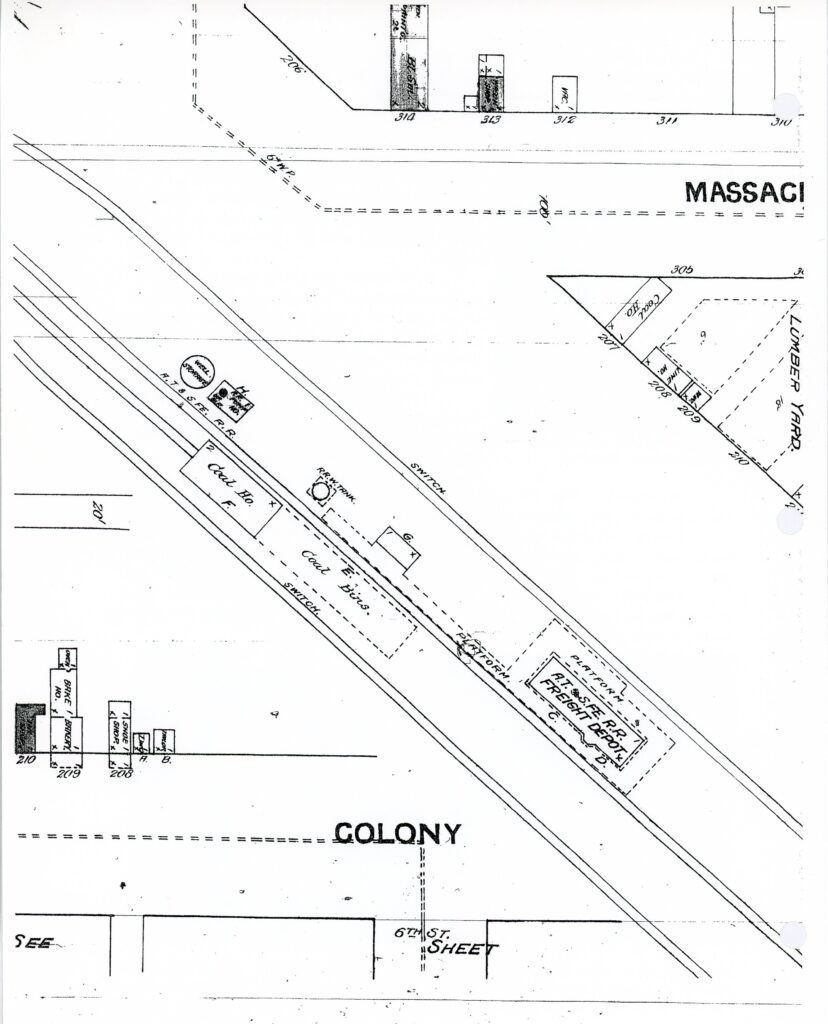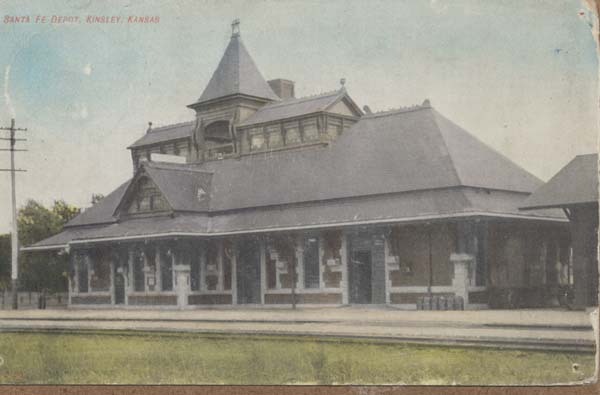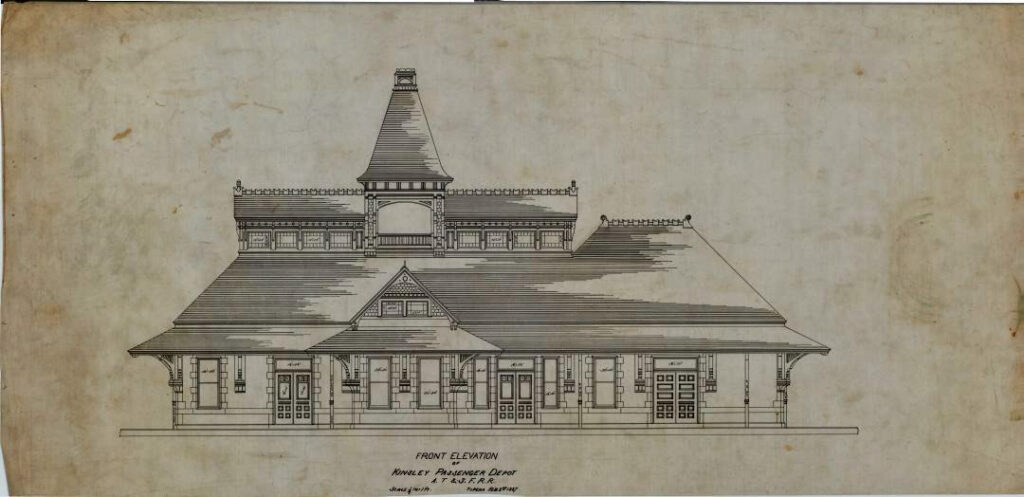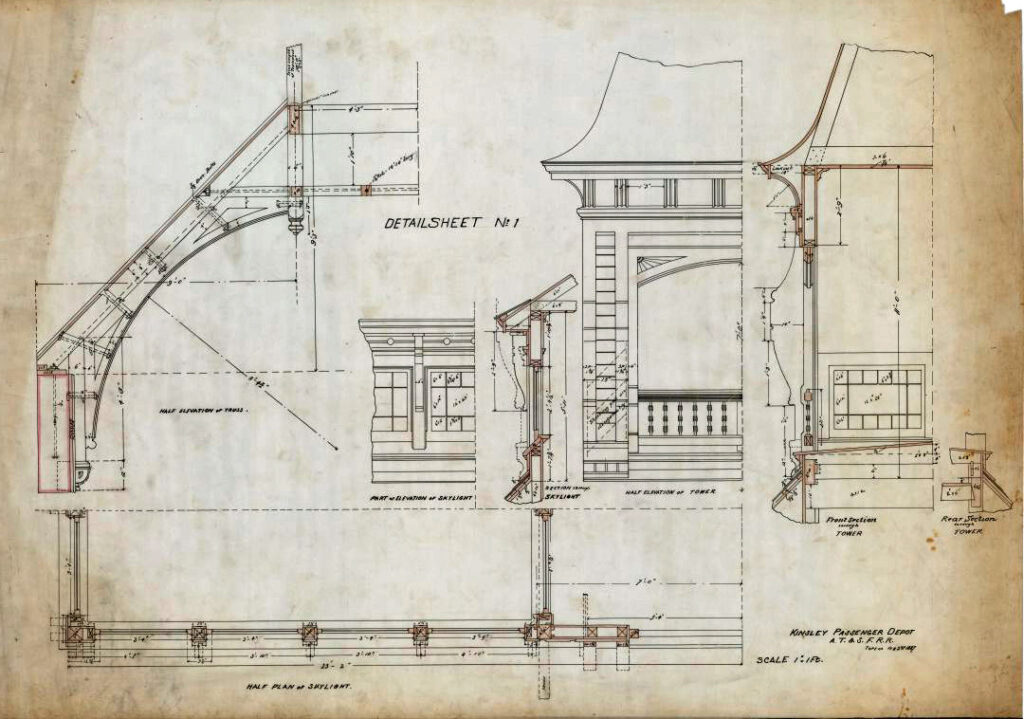Several weeks ago, I began with “I spent much of the weekend working on an exciting archival project which I’ll be telling you about in a future article.” The future is here, it is time to share it with you.
First of all, let me tell you that my library job is never boring. I go into work with my day all planned, and suddenly, it all changes. That was what happened on March 2 when I received a call from retired Santa Fe Railway worker, John Vician of Crystal Lake, Illinois. He wanted to know if the library would like to purchase the original architectural drawings of the Kinsley Depot built in 1887?
“We sure would!” I told him, “if we can afford them.”
I asked architect and Kinsley historian Ed Carlson to contact Mr. Vician who sent snapshots of the drawings to him. After making some arrangements, Mr. Vician sent the drawings to Ed’s home in Olathe on March 11.
I was married to an architect, and I know how excited their creative minds can get. Ed opened up the shipping tube and found twelve large, ink drawings precisely executed on special architectural linen paper. They were also very curled having been rolled up for 130 years. When Ed carefully laid them out and weighted them, he found quite an historical treasure.
Now this 1887 depot, none of you remember. It was very fancy for a town the size of Kinsley. It had a high roof with an impressive center tower. Both were removed in a 1919 renovation and replaced with a much lower roof. That lower-profiled building is the one that you may remember.
A bit of history. The A.T. & S.F. Railway reached Edwards County in 1872. In October, a colony of 500 people arrived on it to establish a town called “Petersburg”. They had chosen to name it after T. J. Peters, a director of the Santa Fe railroad. However, a post office in Kansas already had that name, so in January 1874, they settled on “Kinsley”, naming it after E. W. Kinsley of Boston who had donated money for the Congregational Church.
The “Daily Commonwealth” in Topeka ran an article on March 3, 1874. “The rapid immigration to the Arkansas valley is calling on the A.T. & S. F. railroad company for increased facilities to meet the demands of business.” It continued to report that a contract was let for a wood-frame depot to be built at Kinsley, formerly Petersburg, and was to be completed by May 1. Early maps show this simple depot was located on the northside of the tracks where Colony Ave. crosses them.

Thirteen years later it would be replaced with an impressive brick structure built west of where 8th St meets the tracks. You are invited to see the original plans for that building at an open house on Saturday, May 7, from 1-5 p.m. This will be the only opportunity for the public to view the 130-year-old drawings in Kinsley.

architectural drawings of the Kinsley Depot pictured in this vintage postcard.
You’ll want to be there from 2-3 p.m. when Ed Carlson tells how the small town of Kinsley came to have such a large, ornate depot, how it was constructed, and how it changed in the 1919 remodeling.

that will be on display at the Kinsley Library the afternoon of May 7 from 1-5 p.m.
The A.T. & S.F. Railway would close the depot in 1982 and the B.N.S.F. would demolish it in 1999. Many of you remember that as a very sad day, like losing an old friend.
Neither the library nor the Edwards County Historical Museum is equipped to properly preserve and store these fragile drawings. After the exhibit, Ed will be delivering them to the Kansas State Historical Society in Topeka.
In order to still “keep” them here in Kinsley, I applied for a Humanities Kansas Cultural Preservation Grant. After it was awarded, I took the drawing to the Cimarron Library where Sara McFarland used their large scanner to digitize them. From those scans, we have had four of the drawings printed to size and framed for permanent display in the library.

All twelve digital images will soon be accessible through the library’s collection catalog and on a webpage dedicated to depot history on the library website. I also hope to have Ed’s presentation available there, as well as my companion exhibit of the many roles the depot has played over the years in the lives of the citizens.
Research has determined that these drawings are worth about $500. But their real value is in how they tell the story of Kinsley, in the railroad and architecture history they reveal, and in their innate beauty. We are so grateful to Mr. Vician for offering them to us.
Mr. Vician plans to donate the purchase money to the “Make a Wish Foundation. We are not allowed to use grant funds to buy the drawings. If you would like to contribute to their purchase and also help Mr. Vician realize his charitable dream, we are accepting donations. The Kansas State Historical Society Is looking forward to having Kinsley donate them to the state’s collection.
